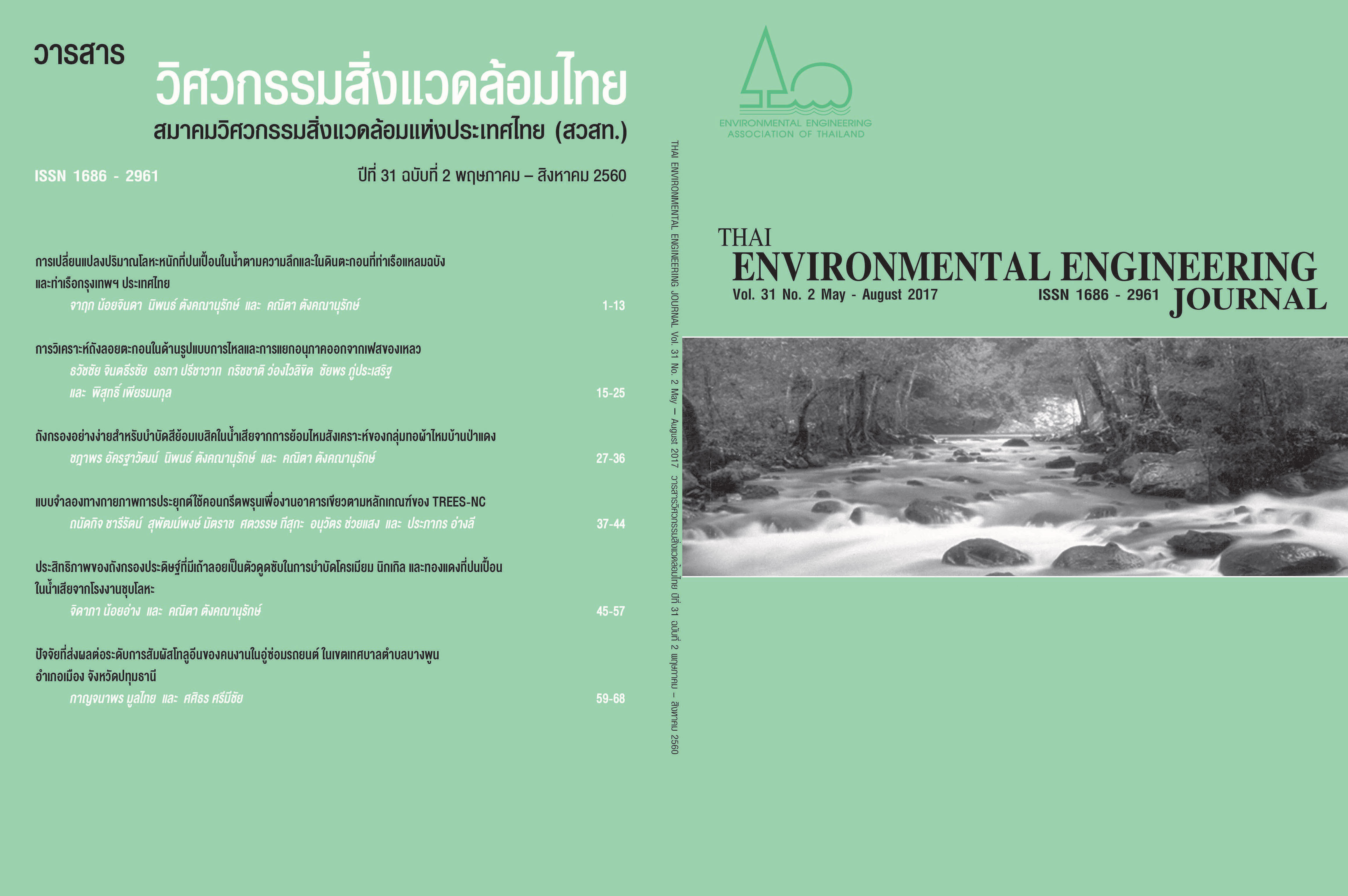Analysis of Flotation Tank in terms of Flow Pattern and Particle Separation from Liquid Phase
Main Article Content
Abstract
Flow patterns of fluid in reactor have an effect on particle separation efficiency by dissolved air flotation process. First part of this study examined the hydrodynamic parameters of the flotation tank including Liquid flow rate (QL), Pressurized water flow rate (QPW), Air flow rate (Qg,1 and Qg,2), and type of air diffuser (D1) by the residence time distribution function theory. The flow patterns were experimentally examined throughout the reactor by pulse tracer input method which Sodium chloride (NaCl) was used as tracer. Dispersion model and Design of Experiments (DOE) were applied to analyze result in term of dispersion number (d; D/uL). The result showed that flow patterns of the flotation tank are Plug flow reactor with large extents of dispersion. The highest D/uL value is obtained at 0 lpm, 7.5 lpm, and 2.5 lpm of QPW, Qg,1, and Qg,2 respectively. Second part, Treatment efficiency of synthetic wastewater containing microalgae and turbid particle was investigated. The optimum operating conditions are 0.15-0.32 mg air/ mg solid of Air to solids ratio (A/S) combined with Alum addition and 0.107-0.112 of D/uL of the flotation tank that the particle separation efficiency is higher than 72%
Article Details
References
[2] Metcalf & Eddy, Inc., Tchobanoglous, G. Burton, F. L. and Stensel, H. D. 2002. Wastewater Engineering: Treatment and Reuse (4th Ed.). United States of America: McGraw-Hill.
[3] Kawamura, S. 2000. Integrated Design and Operation of Water Treatment (2nd Ed.). United States of America: John Wiley & Son, Inc.
[4] Levenspiel, O. 1999. Chemical Reaction Engineering (3rd Ed.). United States of America: John Wiley & Son, Inc.
[5] Valade, M. T., Becker, W. B. and Edzwald, J. K. 2009. Treatment selection guidelines for particle and NOM removal. J. Water Supply Res. T. 58(6): 424-432.
[6] Behin, J. and Bahrami, S. 2012. Modeling an industrial dissolved air flotation tank used for separating oil from wastewater. Chemical Engineering and Processing: Process Intensification, 59: 1-8
[7] Montgomery, D. C. 2008. Design and analysis of experiments. United States of America: John Wiley & Son, Inc.
[8] Minitab, I. 2000. MINITAB statistical software. Minitab release, 13.
[9] APHA, AWWA, and WEF. 2012. Standard Methods for the Examination of Water and Wastewater (22th Ed.). United States of America: APHA.
[10] Shawwa, A. R. and Smith, D. W. 1998. Hydrodynamic characterization in dissolved air flotation (DAF) contact zone. Water Sci. Technol. 38(6): 245-252.
[11] Chegeni, M. H., Abdollahy, M. and Khalesi, M. R. 2015. Column flotation cell design by drift flux and axial dispersion models. Int. J. Miner. Process. 145: 83-86.
[12] Mills, P. J. T. and O'Connor, C. T. 1992. Technical note the use of the axial dispersion model to describe mixing in a flotation column. Miner. Eng. 5(8): 939-944.
[13] Xu, M. and Finch, J. A. 1991. The axial dispersion model in flotation column studies. Miner. Eng. 4(5): 553-562.
[14] Bunker, D. Q., Edzwald, J. K., Dahlquist, J., and Gillberg, L. (1995). Pretreatment considerations for dissolved air flotation: water type, coagulants and flocculation. Water Sci. Technol. 31(3): 63-71.
[15] Henderson, R., Parsons, S. A. and Jefferson, B. (2008). The impact of algal properties and pre-oxidation on solid–liquid separation of algae. Water Res. 42(8): 1827-1845.
[16] Henderson, R. K., Parsons, S. A., and Jefferson, B. (2010). The impact of differing cell and algogenic organic matter (AOM) characteristics on the coagulation and flotation of algae. Water Res. 44(12): 3617-3624.


